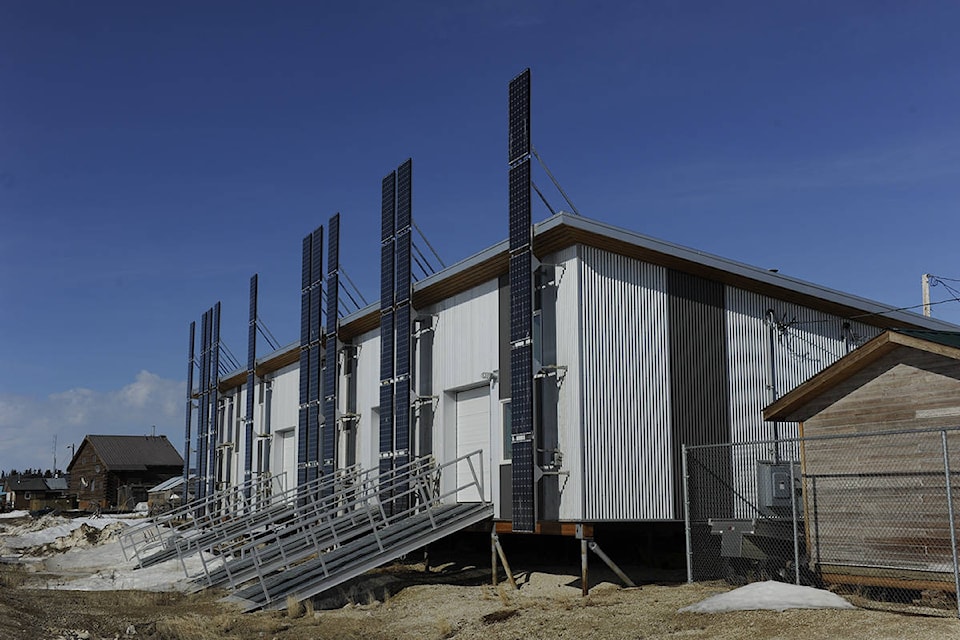An Old Crow solar energy project is “ready to go” but can’t get started without the critical “linchpin” of federal funding, says project organizer and Vuntut Gwitchin councillor Dana Tizya-Tramm.
“We have a project set to begin in 2018,” he said. “But we don’t have a penny.”
Construction of the project, which is designed to produce up to 900 kilowatt hours of solar energy and eliminate some 93,000 litres of diesel consumption, is supposed to start as early as March 2018, said Tizya-Tramm. However, $1 million in promised federal funding through the Innovative Renewable Energy Initiative has not yet come through.
That money is the startup capital for the project, Tizya-Tramm said, and without it the project is basically in limbo.
Tizya-Tramm said there was “somewhat of a pecking order” in the way the funds were delivered. First the federal government has to release the money to the territorial government. That hasn’t happened yet, he said, and there’s no word on when the money will be available.
The Yukon government would then dole out funds for the project through the Yukon Development Corporation, said Brigitte Park, a spokesperson for the Department of Energy, Mines and Resources.
Jeff Wood, a senior policy analyst with the Yukon Development Corporation, confirmed YDC is waiting for the money, but said there was never “a firm commitment from the federal government” on when the funds would be made available.
“The money hasn’t come down yet,” he said. “We don’t even know yet what the terms and conditions for those funds are going to be when they do.”
“The federal government moves at its own pace,” he said.
“The project has been fermenting for quite some time,” Tizya-Tramm said. “We’re a small First Nation government and there are some great attributes to that … but on the other side of that, is that it can be hard and really draining on our resources.”
Tizya-Tramm said that not having the funds available, or even a written promise of when it will be available, cost the project its eligibility for the Arctic Inspiration Prize this year.
“Without this money we have no funds to go after more money…. Without it we just can’t get moving.”
The main problem, Tizya-Tramm said, is that the Liberal federal government simply hasn’t gotten around to it, he said.
Tizya-Tramm said there is no formal word on when the money will be made available, but he expects to know by the end of the fiscal year. This is a problem, he said, because construction needs to start while the ground is still frozen.
“We shouldn’t be having this problem,” he said.
“It would be a shame to lose our hard-earned inertia,” he said. “If it doesn’t move forward now, it’s just a large stone sitting there. It would take a lot of energy to get it moving again.”
Despite the funding difficulties, Tizya-Tramm said that no one with the project holds a grudge or blames anyone. They just want to get started with the project.
ATCO Electric Yukon and the Yukon government have been “great partners” and “willing to come to the table,” he said.
“By no means (do we) harbour any ill will towards anyone,” he said. “Everyone is working together and everyone wants the same thing.”
The Vuntut Gwitchin are “on the knife’s edge” of renewable energy development in the territory and across the country he said. They are currently engaged with talks with ATCO and the Yukon government regarding exactly how much power they can put into the grid. This amount falls under the independent power producers policy (IPP) which is currently being worked out by the Yukon government and power companies.
The IPP policy is scheduled to be completed in 2018.
“Where we’re sitting is actually very interesting,” Tizya-Tramm said. “We’re ironing out a lot of negotiations.”
The number the Old Crow solar project and ATCO have settled on is 450 kWH to be put directly into the grid in Old Crow. This means that on sunny days, the First Nation can turn off diesel generators from April to September, eliminating 16 per cent of its total diesel consumption, said Tizya-Tramm.
“This is just the beginning,” Tizya-Tramm said. “If you have a small community like Old Crow making waves in renewable energy, I think you’ll see traditional communities like Old Crow really setting the pace of renewable energy development.”
“We’re stumbling in the right direction.”
Contact Lori Fox at lori.fox@yukon-news.com
